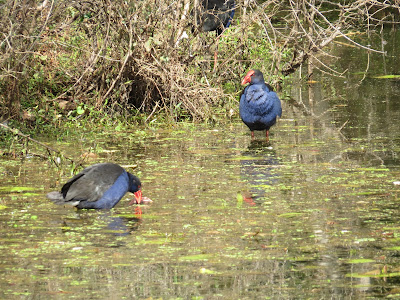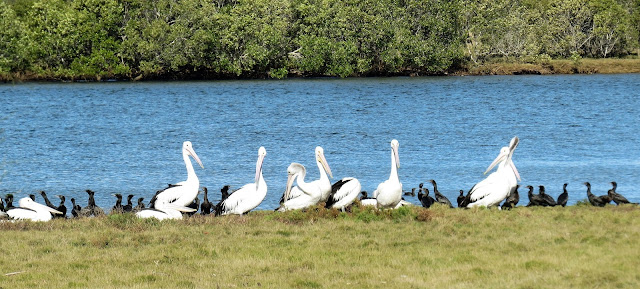I will go through the last one-and-a-half months in chronological order. I have spent most of it studying at university, though I have managed to make the occasional trip away from campus.
Over the 20th=22nd July, I camped at Inskip Point near Rainbow Beach, just north of the Sunshine Coast. Despite it being a fantastic area for bird-life, I was sadly unable to get much birding in, with a Tawny Frogmouth in the campsite being the highlight of the trip.
On the 29th July, I visited my regular location of Kedron Brook Wetlands. I was determined to find a total of at least 50 species there on one visit for the first time. A great number of birds were about, with the highlights being reserve ticks for me in Blue-faced Honeyeater and Fan-tailed Cuckoo (certainly a great surprise!), along with Black Swan, Black-shouldered Kite, Brown Goshawk, White-bellied Sea Eagle, Buff-banded Rail and Mistletoebird. I got back to my car and added up my tally, only to find I had reached 48 species! A quick walk from the car pushed me through the 50 barrier, with Pied Butcherbird, Common Myna and Spangled Drongo all appearing.
My next birding trip of any significance was on the 9th August, when I went to another of my favourite locations, Anstead Bushland Reserve in west Brisbane. Birds were sadly a little hard to find, though I was pleased to spot an extremely distant Australasian Darter perched by the river, a reserve first for me, while further reserve ticks came in the form of a stunning Brown Goshawk pair and a surprise fly-over Australian Pelican.
Brown Goshawk at Anstead Bushland
Not what I expected to see! An Australian Pelican flying high overhead above the bushland
Other nice birds seen on the trip included a White-bellied Cuckooshrike, a small group of Varied Sittellas, numerous Rufous and Australian Golden Whistlers, a single Apostlebird and a Rose Robin. I returned to the reserve on the 29th, where I saw another reserve first for me in the form of a pair of Superb Fairywrens, taking my total there up to 79 species. The Fairywrens, however, were far from being the highlight of the trip. I had sat down on a bench on the reserve and heard a rustling coming from underneath it. I was truly shocked to spot this magnificent three-metre-long beast emerge:
Honestly one of the most magnificent creatures I have seen, the Carpet Python. I watched this snake for close to two hours, at one stage getting to less-than-one-metre away from it! I felt truly enchanted by it, and it was a real honour to have such an a memorable experience with such a resplendent animal.
This had more than made up for my failed attempts to find the family of Masked Owls that had been seen in a small park in Pullenvale the previous day. I had spent the entire morning searching for them, with no luck whatsoever (the highlight was a pair of Australian King Parrots that went overhead).
On the 12th September, I revisited Slaughter Falls at Mount Coot-tha in search of the baby Powerful Owls which had fledged earlier in the month. I was unsuccessful again, though I had a fantastic walk, with this guy the undoubted high point:
Without a doubt, one of the best-camouflaged birds I've seen, the Tawny Frogmouth.
Other birds present included Eastern Spinebill and my first-for-the-season of Leaden Flycatcher, Spectacled Monarch and Black-faced Monarch.
Every time I see a Black-faced Monarch I am struck by their magnificent colours. Like its close relatives the Spectacled Monarch and Leaden Flycatcher, these birds migrate north to tropical Queensland and New Guinea for the winter months, before returning south to breed.
I was also extremely happy when a raptor gliding low over the canopy revealed itself to be a Square-tailed Kite. This was my second sighting ever of this stunning and rare raptor, and it is believed that Brisbane's only breeding pair is resident in Mount Coot-tha Forest. I watched the bird for some time as it seemingly pursued Sulphur-crested Cockatoos. Finding two of these awesome creatures was also fantastic:
A stunning Goanna Lizard. Its response to seeing me was to freeze against the tree, allowing for fantastically close views.
My next trip was on the 21st September, when I headed to the North Lakes in northern Brisbane. I had one target, and after nearly an hour of searching, it appeared. The bird in question was the smallest heron in the world, the Black-backed Bittern (also known as the Australian Little Bittern). This bird is just 25cm in length, approximately equal to the Feral Pigeon! I was totally blown away when a stunningly-bright male of the species briefly landed out in the open on this small lake next to a housing estate, what an extraordinary bird to find in such a location! With an estimated world population of just 5000 adults, being able to see this bird was an immense privilege, and undoubtedly one of the highlights of my year so far. The experience certainly brought back memories of the many futile hours I spent searching for the Britain's only pair of the closely-related Little Bittern. Thankfully I had had more luck today, though sadly my camera had run out of battery! Two Yellow-rumped Thornbills and six tiny Magpie Goslings were also notable sightings here.
I returned to Kedron Brook Wetlands on the 29th September, where I hoped again to find at least fifty species. Once more, I achieved that goal with 52 species seen, including two reserve ticks in Grey Shrikethrush and Leaden Flycatcher, taking my total there up to 96 species! Given I am still yet to visit the reserve and fail to find a new bird for me there, hopefully it won't be long before I reach 100, a fantastic total for a small inner-city reserve surrounded by motorway, a railway track and Brisbane airport.
My first Leaden Flycatcher for Kedron Brook Wetlands. Finding this woodland specialist at a reserve with barely any trees was certainly a surprise!
As always, raptors were common here, with Brahminy Kites, a Swamp Harrier, a White-bellied Eagle and a pair of Black-shouldered Kites seen. A Buff-banded Rail was a very nice treat, while it was nice to find a pair of returning Siberian-breeding waders in amongst large numbers of White-headed Stilts. The first was a Sharp-tailed Sandpiper, a species whose numbers here I would expect to build up over the coming months, while the second was something of a Brisbane rarity in the form of a Common Sandpiper. Since I moved here in September 2015, the only (three) ebird reports of the species in the city have all been from me, and all from Kedron Brook Wetlands! Consequently, I had started to doubt myself, so it was very pleasing to manage to get a record shot of this fantastic little wader today:
Common Sandpiper on the bank of Kedron Brook. This is one of my favourite waders, with its fantastic habit of bobbing its tail up-and-down repeatedly and frantically scurrying about the riverbank.
I was overjoyed to find a Pacific Koel in my neighbour's garden earlier in the week. This bird had been calling virtually daily for the duration of last summer, though I had not seen it once. This time, however, after less than ten minutes of calling, I caught sight of the bird sitting in a small bush. Despite hearing the bird so regularly, this was only the third time I have ever seen the species, and my first time this year. This Cuckoo migrates north to New Guinea and Indonesia for the winter months, so it certainly feels very special to have one returning to our suburb.
Finally, I visited Osprey House Environmental Centre in northern Brisbane this afternoon. I was searching for more Siberian-breeding waders, and I was pleased to find decent numbers present here. A mixed flock of Great and Red Knots and Bar-tailed and Black-tailed Godwits was feeding on the muddy estuary, the latter surprisingly my first in Australia, but I feel like this has definitely been an oversight! Excluding the Bar-tailed Godwit, these birds, along with a small group of Red-capped Plovers represented firsts for me in Brisbane, meanwhile other migrant waders seen included numerous Whimbrels and Far Eastern Curlews and a small group of Red-necked Stints. There are still a number of other species of wader that I need to find in Brisbane, and I was immensely impressed by this area, so I will certainly be returning! Hopefully the Asian Dowitcher reported from there earlier in the month will return...
Meanwhile, I will be trying to do as much birding as possible over the coming months, though I will be very busy with university. Hopefully I'll be able to find some more great wildlife!
Brisbane year total: 210; additions: 7 (Square-tailed Kite, Black-backed Bittern, Pacific Koel, Black-tailed Godwit, Red Knot, Great Knot, Red-capped Plover)

































































